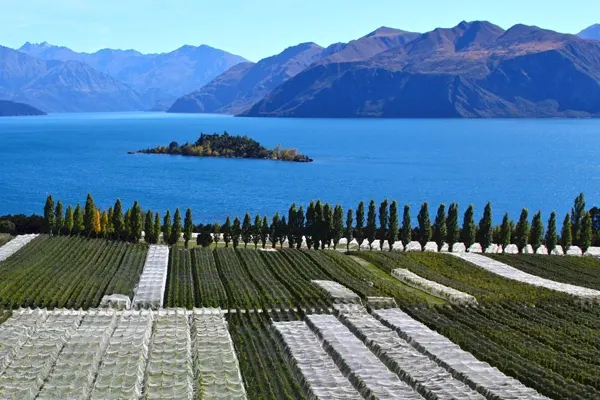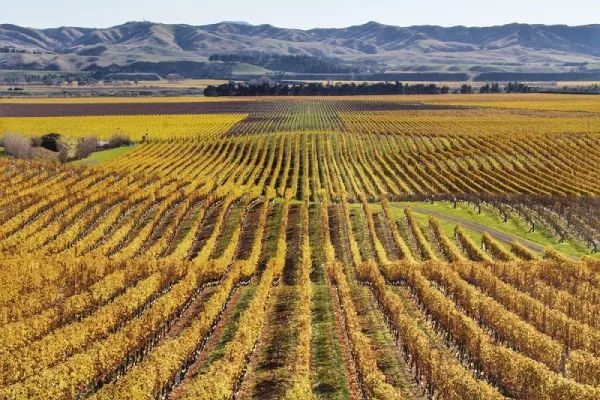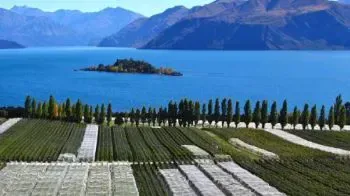The first vines were planted in 1840, in Kerikeri, North Island, by missionary Samuel Mardsen. However, the first wines only started to be produced 20 years later. Currently, the country produces wines that stand out for their precise and pure taste. It exports an average of 58.7 million liters of wine per year and has 10 wine production regions in which around 530 wineries operate.
New Zealand
The territory of New Zealand is extensive, with about 15 134km of coastline and a total area of 268 021km². It belongs to Oceania, is 2000km from Australia, separated by the Tasman Sea, and its closest neighbors are Fiji and Tonga.
It is an island country, made up of two main landmasses (the North Island and the South Island), and some smaller islands.
New Zealand’s Terroir
New Zealand's climate varies greatly. Most parts of the country receive over 2000 hours of sunshine per year, as the average rainfall is high and evenly distributed throughout the year. In the north and center it rains more in winter than in summer, but in most of the south of the country, winter is the season when it rains less.
Soils on the east coast of the North Island are seasonally dry and rich in limestone. Canterbury Plains on the South Island has shallow, dry, stony soils. On the west coast of the South Island, the soil is moist and formed under dense native forest.
This type of terroir produces fantastic and complex whites, as well as fine and tasty reds.

Image: Jornal da Orla
New Zealand Wine Regions
New Zealand is made up of ten wine regions, all of which have different terroirs, which makes the characteristics of the wines unique.
- Northland: tropical Chardonnays, the popular Pinot Gris, and vibrant Viogniers lead the growth of white wine in the region. The red wines produced include spicy Syrah, elegant blends of Cabernet and Merlot, spicy Pinotages and complex Chambourcin.
- Auckland: is one of New Zealand's oldest wine regions. Spread over a large and diverse area, it encompasses three distinct sub-regions, Waiheke Island, West Auckland and the coastal enclave of Matakana.
- Waitaki: is a relatively new wine region, but the complex limestone and shale soils have attracted many producers.
- Gisborne: is the birthplace of a mixture of large and small producers, who explore new varieties and places to innovate in wine production.
- Hawkes Bay: is the second largest region in the country, producing some of New Zealand's finest wines.
- Nelson: long known for its harvests, the roots of this region's wine were cultivated in the mid-1800s.
- Marlborough: brought New Zealand into the world of international wine with its famous Sauvignon Blanc in the 1980s and is the country's largest wine region.
- Cantenbury: the wines are known for their intense flavours, richness and complex fruit.
- Central Otago: is known for producing excellent Chardonnay and Sauvignon Blanc. All of the major wine-growing subregions have diverse mountain terrain, providing varying climates and altitudes.
- Wairarapa: its main subregions have a similar climate and soils but the wines offer subtle differences in character that the most discerning palate recognizes.
New Zealand Wine Types
The country produces countless wonders, such as the fantastic, long-lasting and complex Chardonnays. Some good examples of this success are the Kumeu River, Isabel Estate and Elston, from Te Mata. New Zealand red wines are also world renowned for being very fine and flavourful.
New Zealand's finest Cabernets are produced in the warm Hawke’s Bay region, mainly in Te Mata. Coleraine and Awatea are elegant red wines in the style of those produced in the Bordeaux region of France and are true icons in the country.

Image: Fotos e Destinos
New Zealand Grape Varieties
A few years ago, Marlborough's Sauvignon Blancs were responsible for drawing the world's attention to New Zealand wines, but today most of their varieties and regions are respected and appreciated.
Northland: Chardonnay, Syrah, Pinot Gris and Merlot.
Auckland: Chardonnay, Syrah and Pinot Gris.
Waitaki: Pinot Noir, Pinot Gris, Riesling and Chardonnay.
Gisborne: Chardonnay, Pinot Gris, Sauvignon Blanc and Gewürztraminer.
Hawkes Bay: Merlot, Chardonnay, Sauvignon Blanc, Pinot Gris, Syrah and Pinot Noir.
Nelson: Sauvignon Blanc, Pinot Noir, Pinot Gris and Chardonnay.
Marlborough: Sauvignon Blanc, Pinot Noir, Pinot Gris and Chardonnay.
Cantenbury: Pinot Noir, Sauvignon Blanc, Riesling and Pinot Gris.
Central Otago: Pinot Noir, Pinot Gris, Chardonnay and Sauvignon Blanc.
Wairarapa: Pinot Noir, Sauvignon Blanc, Pinot Gris and Syrah.
 Portugal
Portugal Spain
Spain France
France Germany
Germany United Kingdom
United Kingdom Monaco
Monaco



